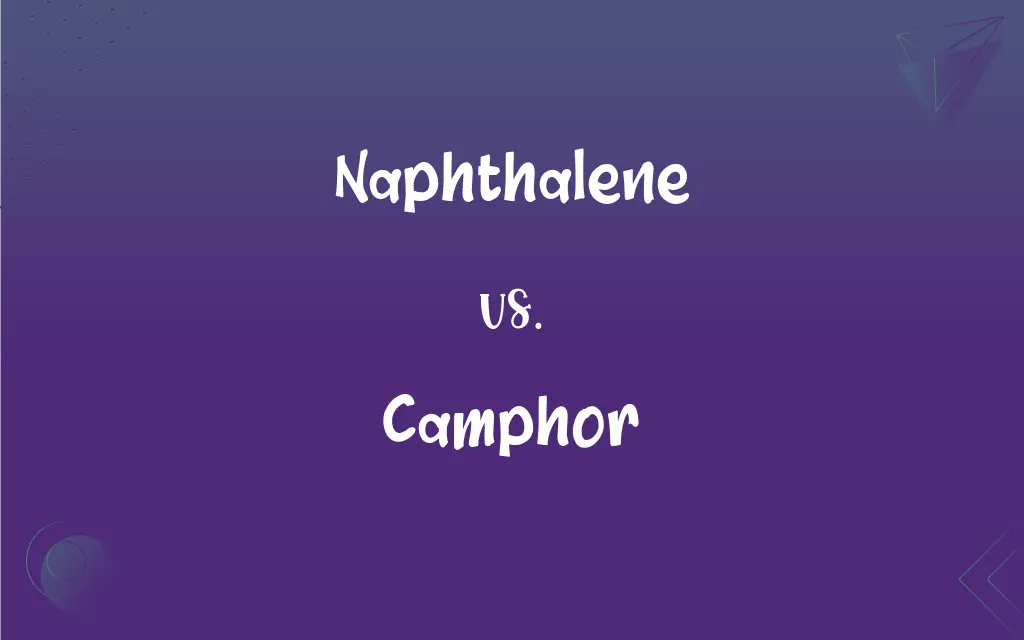Naphthalene vs. Camphor: What's the Difference?
Edited by Aimie Carlson || By Janet White || Published on February 13, 2024
Naphthalene is a hydrocarbon used as a moth repellent, while camphor, derived from the camphor tree, is used in medicine and as a fragrance.

Key Differences
Naphthalene is a hydrocarbon with a distinct two-ring structure, typically derived from coal tar or petroleum. Camphor, on the other hand, is an organic compound obtained from the wood of the camphor tree and characterized by its strong aroma.
Naphthalene is widely known for its use as a moth repellent and in the production of other chemicals. Camphor is utilized in medicinal applications, including as a topical analgesic and an anti-inflammatory, and in aromatherapy due to its strong, penetrating odor.
Naphthalene appears as white, crystalline flakes with a strong, pungent odor and is insoluble in water. Camphor is also crystalline but is characterized by a waxy texture and is slightly soluble in water, with a strong, aromatic odor.
Naphthalene is considered hazardous, with potential health risks if inhaled or ingested. Camphor, while also having toxic properties at high doses, is generally used in much safer, medicinal forms.
Naphthalene has been used for decades in mothballs and as a pesticide. Camphor has a long history in traditional medicine, especially in Asia, and is also used in religious ceremonies and as a flavoring agent in some cuisines.
ADVERTISEMENT
Comparison Chart
Chemical Structure
Aromatic hydrocarbon with two rings
Organic compound with a characteristic odor
Primary Use
Moth repellent, chemical precursor
Medicinal applications, fragrance
Physical State
White, crystalline, pungent odor
Waxy, crystalline, aromatic odor
Solubility in Water
Insoluble
Slightly soluble
Environmental Impact
Hazardous, toxic if inhaled
Toxic in high doses, used medicinally
ADVERTISEMENT
Naphthalene and Camphor Definitions
Naphthalene
An aromatic hydrocarbon derived from coal tar.
The distinct smell of naphthalene originated from the newly opened package.
Camphor
Derived from the wood of the camphor tree, used in aromatherapy.
The soothing scent of camphor filled the spa.
Naphthalene
Naphthalene, a polycyclic aromatic hydrocarbon, is used in chemical manufacturing.
The factory specializes in converting naphthalene into various industrial products.
Camphor
Camphor is used as a plasticizer and in the production of celluloid.
Camphor was added to the mixture to enhance the plastic's flexibility.
Naphthalene
A volatile compound used as a pesticide.
Naphthalene flakes were scattered in the garden as a pest deterrent.
Camphor
A waxy, flammable substance with a strong aroma, used medicinally.
Camphor cream was applied to relieve muscle pain.
Naphthalene
A white crystalline substance used in mothballs.
We placed naphthalene balls in the closet to prevent moth damage.
Camphor
A substance with antifungal and antibacterial properties.
Camphor is included in some topical antifungal treatments.
Naphthalene
A compound with the molecular formula C10H8.
The chemical analysis confirmed the sample to be pure naphthalene.
Camphor
A compound used in traditional medicine and religious ceremonies.
Camphor was burned during the ritual for its purifying fragrance.
Naphthalene
A white crystalline aromatic compound, C10H8, derived from coal tar or petroleum and used in manufacturing dyes, moth repellents, and explosives and as a solvent. Also called tar camphor.
Camphor
A fragrant white or colorless crystalline ketone, C10H16O, obtained naturally from the wood of the camphor tree or synthesized from pinene and used as an insect repellent, in the manufacture of film, plastics, lacquers, and in medicine chiefly in external preparations to relieve mild pain and itching.
Naphthalene
A white crystalline hydrocarbon manufactured from coal tar; used in mothballs.
Camphor
(organic compound) A white transparent waxy crystalline isoprenoid ketone, 1,7,7-trimethylbicyclo[2.2.1]heptan-2-one, with a strong pungent odour, used in pharmacy.
Naphthalene
(organic compound) An aromatic bicyclic hydrocarbon, C10H8; an acene containing two fused benzene rings.
Camphor
A tough, white, aromatic resin, or gum, obtained from different species of the Laurus family, esp. from Cinnamomum camphara (the Laurus camphora of Linnæus.). Camphor, C10H16O, is volatile and fragrant, and is used in medicine as a diaphoretic, a stimulant, or sedative.
Naphthalene
A white crystalline aromatic hydrocarbon, C10H8, analogous to benzene, and obtained by the distillation of certain bituminous materials, such as the heavy oil of coal tar. It is the type and basis of a large number of derivatives among organic compounds. Formerly called also naphthaline.
Camphor
Originally, a gum resembling ordinary camphor, obtained from a tree (Dryobalanops aromatica formerly Dryobalanops camphora) growing in Sumatra and Borneo; now applied to its main constituent, a terpene alcohol obtainable as a white solid C10H18O, called also Borneo camphor, Malay camphor, Malayan camphor, camphor of Borneo, Sumatra camphor, bornyl alcohol, camphol, and borneol. The isomer from Dryobalanops is dextrorotatory; the levoratatory form is obtainable from other species of plants, and the racemic mixture may be obtained by reduction of camphor. It is used in perfumery, and for manufacture of its esters. See Borneol.
Naphthalene
A white crystalline strong-smelling hydrocarbon made from coal tar or petroleum and used in organic synthesis and as a fumigant in mothballs
Camphor
To impregnate or wash with camphor; to camphorate.
Camphor
A resin obtained from the camphor tree; used in making celluloid and liniment
FAQs
What is camphor?
Camphor is a waxy compound with a strong aroma, used medicinally and in fragrances.
Where does camphor come from?
It's obtained from the wood of the camphor tree.
Can camphor be ingested?
No, it's toxic if ingested and should only be used externally.
Can naphthalene be used in pest control?
Yes, it's effective as a pesticide.
What is naphthalene?
It's a white, crystalline hydrocarbon, often used in mothballs.
How is naphthalene made?
Naphthalene is derived from coal tar or petroleum.
Can naphthalene be used in medicine?
No, it's primarily used as a moth repellent and in chemical synthesis.
What are the medicinal uses of camphor?
Camphor is used as a topical analgesic and anti-inflammatory.
Is naphthalene safe to use around the home?
Caution is advised as it's hazardous and toxic if inhaled.
What does naphthalene smell like?
It has a strong, pungent odor.
How should naphthalene be stored?
In a cool, dry place, away from food and out of reach of children.
Is camphor used in cooking?
In small quantities, it's used as a flavoring agent in some cuisines.
Can naphthalene dissolve in water?
No, it's insoluble in water.
Can camphor be used on the skin?
Yes, in diluted forms, it's used in topical creams and ointments.
Are there any environmental concerns with naphthalene?
Yes, it's toxic and can be harmful to the environment.
Is camphor environmentally friendly?
In moderate use, it's relatively safe, but high doses can be toxic.
What are the risks of using naphthalene?
Inhalation or ingestion can be harmful, causing health issues.
What does camphor smell like?
Camphor has a strong, penetrating, aromatic odor.
What are the religious uses of camphor?
It's used in religious ceremonies for its purifying fragrance.
What are the physical properties of camphor?
Camphor is waxy, flammable, and slightly soluble in water.
About Author
Written by
Janet WhiteJanet White has been an esteemed writer and blogger for Difference Wiki. Holding a Master's degree in Science and Medical Journalism from the prestigious Boston University, she has consistently demonstrated her expertise and passion for her field. When she's not immersed in her work, Janet relishes her time exercising, delving into a good book, and cherishing moments with friends and family.
Edited by
Aimie CarlsonAimie Carlson, holding a master's degree in English literature, is a fervent English language enthusiast. She lends her writing talents to Difference Wiki, a prominent website that specializes in comparisons, offering readers insightful analyses that both captivate and inform.































































